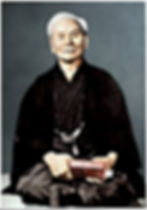Karate History: Naha-Te vs. Shuri-Te
- Dave Lowry
- Sep 11, 2024
- 4 min read

Karate practitioners with any interest in the historical roots of their art will be familiar with the terms Naha-te and Shuri-te. They refer, very generically, to the two major “styles” of Okinawan karate. Understanding the distinctions in Naha-te vs. Shuri-te can provide valuable insights into their historical development and influence.
Some will know, too, that we can determine the pedigree of a karate system through the heritage of these two styles. Shorin-ryu, for instance, comes basically from the Shuri-te tradition, while the bulk of goju-ryu evolved from Naha-te. Here is a comparison between Naha-Te vs. Shuri-Te.
Beyond that, these two iterations of karate aren’t really understood or appreciated by many practitioners. The distinctions and unique characteristics of the two are intriguing, and they offer important insights into the karate we practice today.

While our image of Okinawa and the other Ryukyu islands is largely shaped by World War II, from very early on, the chain was seen as a crossroads, a convenient, neutral stopover and trading spot for much of Asia.
Naha has always been, and is today, the principal port city of the Okinawan islands. For centuries, Okinawans conducted business with the rest of Asia on this small spit of land. Ships from southern China, Japan, Korea and elsewhere anchored in the harbor. It was one of the most cosmopolitan places in that part of the world.
In 1852, American Commodore Matthew Perry came ashore for the first time at Naha. He brought sailors and traders on his way to forcibly opening mainland Japan to the West.
Think about it: Travelers of all sorts gathered at the inns and bars that were crammed into Naha. There was a constant influx of new ideas, and that included fighting techniques. An observant patron of a rough, rowdy Naha saloon or a worker on the docks could have seen an Indonesian silat head butt, the flickering hand strikes of Chinese praying-mantis boxing, the brawling techniques of Boston sailors or the moves of Japanese jujitsu. It would have been a remarkable array of combat methods, all practiced by native exponents.
Naha was a vibrant melting pot of fighting arts. Elements were enthusiastically incorporated into the indigenous combat systems. Systems like goju-ryu and shito-ryu trace their origins back to this time and place.

Shuri is less than 3 miles from Naha. Today, it’s just a neighborhood of Naha, but in the olden days, Shuri was the home of the king and much of the yukatchu, the island’s ruling class. It was, in some sense, a world away from free-wheeling Naha. Shuri was an enclave, and at its center was Shuri Castle, a miniature version of Beijing’s Forbidden City.
Trivia note: Commodore Perry pushed his way into the castle precincts; he did not, though, get the audience he wanted with the 10-year-old king.
In karate terms, Shuri was where karate was practiced by the upper classes. The yukatchu maintained their own traditions and developed their own versions of the art that have come down to us as shorin-ryu, shotokan and other styles.
Two important points must be inserted here. One, these are generalizations. Especially after the beginning of the 20th century, there was much cross-pollination between the systems and practitioners on both sides, and no one today reasonably can claim to be pursuing a completely unadulterated style of either. Two, nothing should be presumed about one system being more “real” than the other. Both lineages are full of legendary masters revered in karate dojo, both are sophisticated fighting arts and both are utterly worthy of study.
That said, the image among Okinawan karateka in the first half of the 20th century was colored by the perceptions that Shuri-te-based karate was more “aristocratic” and Naha-te-based karate was more “blue collar.” These perceptions were pronounced on Okinawa, and when karate moved to the Japanese mainland, they carried over.
It didn’t matter that Chojun Miyagi (1888-1953) was the adopted son of a wealthy Ryukyuan merchant. Because he’d begun his karate studies in a dojo associated with Naha-te — and because, despite his family’s wealth, they were not of Okinawa’s traditional upper classes — his reputation was that of a rough, tough guy.

In contrast, Gichin Funakoshi (1868-1957), because he was of the shizoku class, a relatively low level of yukatchu but aristocracy nonetheless, was seen as more of a scholar-gentleman. The karate taught by Funakoshi and others who descended from these upper classes had a veneer, at least, of refinement.
The yukatchu of Okinawa was formally abolished in 1875, after Japan annexed the islands. This is usually mentioned incidentally in Okinawan karate histories, while in reality, it was a profound, world-changing event in the Ryukyu. Stripped of not only their titles but also their lands, many yukatchu were forced to work in the fields or in jobs they previously would have considered menial. It was humiliating, even devastating, for some of them.
In this context, we can see that karate, once the exclusive property of the yukatchu, would have been one of the only remaining treasures of their original status. They would have protected it and encouraged the belief that their art was superior to arts of the common classes. It’s a fascinating aspect of karate’s history, one we still can see if we know how to look at it.
